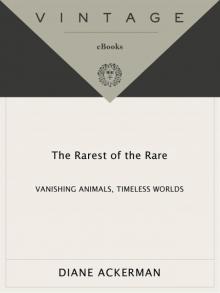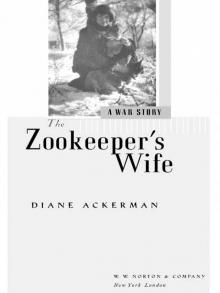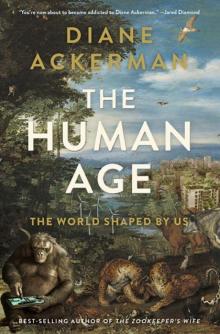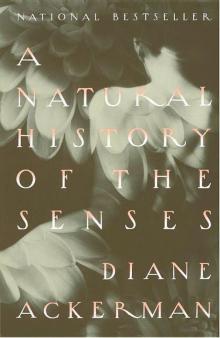- Home
- Diane Ackerman
The Rarest of the Rare Page 2
The Rarest of the Rare Read online
Page 2
Dipping again into The Home Planet, I stop at a photograph of the Rio Negro, winding through the Amazon Basin in Brazil. My memory telescopes from space down to river level, where I snorkeled in waters dark and clear as quartz. A hundred miles southwest, the tannin-brown Rio Negro mixes with the pale Amazon in what’s celebrated as the “Wedding of the Waters.” I have walked and floated and slept along that river, whose banks teem with still-unnamed plants and animals. Going ashore is like entering a thick green vault. I remember the sting of fire ants, the fluorescence of a blue arrow poison frog. I was not then perplexed by frogs; now I am.
Frogs are disappearing all over the world. A friend tells me that when he was working in Panama, he discovered that traces of insect repellent on his hand could kill any frog he inadvertently touched. I’ve also heard that a virus, spreading across six continents, may be responsible for the demise of frogs. There used to be a beautiful golden toad in Monteverde, Costa Rica, that the local people enjoyed for years. Recently the people reported that none have been seen. No one knows if they’re extinct or not, but they may well be. For most people, frogs aren’t glamorous enough to be concerned about. But the speed at which frogs are disappearing should scare the hell out of us. As Paul Ehrlich has said, losing a species is like popping rivets on a plane’s wing. You can pop an awful lot of rivets on a wing and probably the plane will not go down. But no engineer would want to be on that plane, popping rivets to see how many it took to make the plane go down. You might safely be able to pop as many as a hundred. But then you would get down to key rivets and not-so-key rivets. At what point would you have popped enough so that when the next one went, the whole contraption crashed? To change the analogy, think of chopping down a tree. When you first start chopping, the tree can heal, and it won’t fall down. Chop a little farther, and it probably will survive if a big wind doesn’t come soon. Chop a little farther, and it’s going to fall down, no matter what. It’s like that with life on earth. We’re nibbling away at it without knowing when the point of no return will be reached.
It’s tempting to think only large, attractive endangered animals should be protected. Most people feel their lives would be improved if more insects went extinct. But life on earth needs its insects, just as it needs its bacteria. People often think of bacteria as a cause of illness and death, and yet if we didn’t have beneficial bacteria around, we would soon be gone. An array of biologically important bacteria has recently been identified in bat guano found only in specific caves; if we lost the bat colonies in those caves, we would also lose a lot of biodiversity we need.
A genetic palette of many colors, biodiversity is crucial to the survival of life on earth, and also to our health. In a burst of spirituality, it’s tempting to picture this as a sort of rigid morality play: multitudes of plants, insects, and fish put on earth to provide the perfect antidote to specific human diseases. As digitalis (foxglove), quinine (cinchona bark), aspirin (willow), and thousands of other drugs have shown us, the rain forest’s pharmacopoeia is indeed richly healing, and this is because of the deep kinship of all living things. A segmented worm seems radically different in shape, function, and form from a hydrangea, or an ocelot, or a college swim team. We picture life on earth as a feast of wildly distinct entities, but on the molecular level, they differ very little. They have cells, organs, fluids that contain similar stuffs, perform similar functions. Earth’s chemicals can cancel, inflame, dilute, calm, deflect one another—as pigments do when you mix them—because, essentially, they’re all composed of the same raw materials. A chimpanzee seems radically different from a human; but our genes differ from theirs by less than 1.6 percent. There is a deep-down kinship among all living things, not just spiritually, or morally, or through some accident of our being neighbors, but physically, functionally, in our habits, in our hungers, in our genes. Our common ancestor was life, and, at that, a rare form—earthlife—which developed its own basic shapes, symbioses, and motives. That will always make us more closely related to a panda than to a stone, and probably also more closely related to any facet of earthlife than to life-forms we may discover elsewhere in the universe. Superficially, an armadillo looks different from a kumquat; but Earth’s bio-families are tightly related.
As more and more species become rare, angles of color will be deleted from this living kaleidoscope, reducing the possible combinations. Variety is not only the spice of life, it’s the indispensable ingredient. So should we preserve the last remaining smallpox virus? “What good has smallpox ever done anyone?” people argue. “Think of all the suffering it’s caused. Let’s obliterate it once and for all.” I’m glad it’s locked up safe, and I pray it never escapes from its prison; but it may one day offer us an insight into, or solution to, a biological trauma we can’t now imagine.
What could be thornier than the complex problems of ecoethics? I suspect there will one day be many university departments and think tanks dedicated to such debates. I only know that, for me, life is an unlikely and extraordinary happenstance, a fascinating predicament for matter to get itself into. I cherish life’s variety and would like as much of it around as possible.
Why do we treasure what is rare? The word rare implies unusual quality enhanced by permanent infrequency. Rarity is not the same as scarcity, a temporary state. We come from a long line of cooperative creatures—shouldn’t we value all that unites us? First, consider the part novelty plays in our heritage, indeed, in our cells. Our senses respond to changes in the environment. A lion standing in the grass isn’t a threat until that lion turns its head toward you and begins an attack. If you have survived lion attacks before, perhaps you will recognize the first milliseconds of danger—the lion’s eyes locking on to you and fixing you in space, the tightening of its shoulder muscles, the dropping of its head as it begins to sprint. When something changes in such a scene, our neurons signal a change. The body goes on alert. A silent whistle blows in the flesh. The body tenses to fight or flee.
Stasis, which we long for because it’s safe and restful, soon bores us: the body slurs over the details. If nothing changes, the neurons can stay calm. Adrenaline isn’t required. The blood pressure needn’t rise. The brain needn’t stir from its catnap. Otherwise, we would live in a snowstorm of sensation, a kind of sensory noise. We would be continuously aware of the feel of a watchband, a sweater, a pair of glasses. We would never be able to take anything “for granted,” as we like to say. For life’s racket to become a polite blur, against which food or danger looms, we must take it for granted. But we also crave the feel of our response to change, which shakes us wide awake and makes every detail of the world seem suddenly important, distinct, sharply defined. When something new appears, we assess it in depth, with all of our senses paying strict attention, just in case it is a threat, or a source of nourishment, or a harbinger. All at once, adrenaline pours, the pulse quickens, blood flows faster, the muscles contract and prepare for a tough workout. If we stand still and don’t flee or pounce, all that welcome turmoil stays bottled up, and we feel ready to boil out of our skins. We feel a thrill that grows steeper with the magnitude of the threat or the opportunity at hand. Studies have shown that when an unfamiliar woman enters a room, the testosterone level of the men rises. Novelty excites us viscerally.
But it also excites us as an idea. What is life? we ask, knowing that the answer will come not as a headline but as an aggregate. Life is dewclaws and corsages and dust mites and alligator skin and feathers and whale’s whiskers (as mammals, whales do have hair) and tree-frog serenades and foreskins and blue hydrangeas and banana slugs and war dances and cedar chips and bombardier beetles. Whenever we encounter something that is rare, we mentally add it to the seemingly endless list of forms that life can take. We smile in amazement as we discover yet another variation on an ancient theme. To hear the melody, we must hear all the notes. So we’re drawn to new notes, notes our friends have not yet heard.
Sometimes it is difficult for us collectors of rare artifacts
such as paperweights or buttons or paintings to understand that we ourselves are rare. We may be the rarest animal of all, and we are by far the most dangerous. We like to gloat about being at the top of the food chain, but the truth is that we jumped line. Other animals are faster, tougher, stronger, better armored. What we are is mindier. Our brains indulge in a form of mischief that, for lack of a better word, we call thought. We are among the rarest of the rare not because of our numbers, but because of the unlikeliness of our being here at all, the pace of our evolution, our powerful grip on the whole planet, and the precariousness of our future. We are evolutionary whiz kids who are better able to transform the world than to understand it. Other animals cannot evolve fast enough to cope with us. It is possible that we may also become extinct, and if we do, we will not be the only species that sabotaged itself, merely the only one that could have prevented it. Because vast herds of humans dwell on the planet, we assume we are invulnerable. In a sense, we are a virus that has swept over the world, changing and devouring it. Whether or not we are a plague remains to be seen. Because our cunning has allowed us to harness great rivers, to fly through the sky, although we were not born to, and even to add our artifacts to the sum of creation, we assume we are omnipotent. Because we have invented an arbitrary way to frame the doings of nature, which we call time, we assume we are immortal.
For the past years, I’ve been traveling to see some of the rarest animals and ecosystems. As a member of the species responsible for their downfall, I feel an urgent need to witness and celebrate them before they vanish. But my motives are also selfish: I ache to know how dinosaurs ran, what their skin felt like, what sounds they made, how they cosseted their young. There are little-known species alive among us now that have lived on the planet for millions of years longer than we have but will perish without our noticing them, without our chronicling their ways and habits. I find that thought unbearable. So many plants and animals are endangered that it would be impossible to write an exhaustive book on the subject. So I’ve chosen here to focus on three delegate animals (monk seals, short-tailed albatrosses, and golden lion tamarins), two endangered ecosystems (the Amazon and the Florida scrublands), and an “endangered phenomenon” (the migration of the monarch butterfly). They are some of the errands life is running at the moment. I couldn’t resist tagging along.
For me, that has always meant observing the animals in their natural habitat while working with scientists who have devoted their lives to them. That usually requires at least a small pilgrimage, which I find nourishing in countless ways. But sometimes I find myself described as “a hard-core adventuress,” to use one reviewer’s words. Meant as a compliment, that emotional silhouette is far removed from my motives and disposition. I guess people associate violence and brutality with the wilderness and don’t think of women as feeling at home there. When Giraudoux writes in Ondine, “A woman’s hand, no matter how soft, can become a shell of iron when it protects a living thing,” he means not that the woman changes into a Valkyrie, but that softness and strength are not incompatible. There is a strength one rises to in rare moments, a stretch of cunning or physical ability. And there is a strength one pares down to, a tundralike patience, self-denial, or determination. Both can occur as often in the inner city or on a college campus as in the Amazon.
At thirteen, I desperately wanted to be what I then thought was called an adventuress. It took me years to discover the true landscape of that word, with its night-prowling denizens and emotional quicksand. And it took further years to understand that I didn’t mean “adventurer,” either; I meant some sort of naturalist/poet who patrolled the wilds of the world and the emotional jungle of ourselves with snares made of sentences and darts tipped with wonder. There was a literary tradition to join, though I didn’t suspect it at the time, which included stylish fiction writers such as Melville and Conrad, who had tramped through what Wallace Stevens would later call “the wild country of the soul,” and also rhapsodic nonfiction writers like Loren Eiseley and Guy Murchie, and literate explorers like Sir Richard Burton, among many others. They electrified armchair travelers like me with their sensory caravans. Now movies and television perform that function for many people, but I still love to see the world through the handheld lens of a book, to add others’ sights and insights to my own.
I love to sketch with words and try to make portraits of life in process, and to ponder things. Some overly solemn people, who seem to know too much about what nature is for to be able to enjoy it, feel that you can’t be serious without being preachy, nor sincere without being earnest. Nature is indeed sacred and must be protected. We should all care urgently about the fate of our animals and ecosystems, and should work hard in their behalf. But nature is also great fun. To pretend that nature isn’t fun is to miss much of the joy of being alive, and to deny the curiosity, restlessness, celebration, spirituality, invention, play, and other quirks that make us characteristically human. If I respect the unique ways of the elephant or the bower bird, should I not respect the unique ways of the human?
I pray there will be no mishaps on expeditions, and I always try to avoid discomfort. But there is no use pretending that it isn’t good old-fashioned fun sometimes when you discover that you have to get really and truly mucky—reaching into a burrow to check an Antarctic prion, wading up to the thighs in ropy Amazonian mud, shuffling through guano thick as peas. Sometimes the filthier, hungrier, sorer, and more weather-beaten I get, the more I feel a deep-down child-of-the-earth radiance. Few things are as satisfying as meeting nature on its own terms, attending to its rhythmic demands, and then trying to snare it briefly in the net of the imagination, studying its gestures and moods, and making the drama that normally spins out in four dimensions pause a moment and roost temporarily in two.
When I read my notebooks later, they escort me back to people, places, and events I may never experience again. The cartography of life changes so quickly. It made sense that I felt this way about the albatross expedition, a difficult sea journey; but I was surprised to find that each of these expeditions filled me with that same bristling urgency. Although I was usually safe and comfortable, each day was a matter of life or death for the animals I traveled to see, so an alarm kept ringing in my chest. Returning home after each trip, I underwent a torrent of emotions, including privilege and wonder, determination to help the animals in whatever ways I could, and that special pang one feels saying good-bye, just in case, to war-bound friends.
MONK SEALS
In the mythos of the folk who make their living from the sea it is well known that hidden in the dark pools of the eyes of certain seals are spirits that call out to certain men. The Irish among us, and a few Scandinavians who have lived long at the edge of the sea, can hear the message best. These seals, they say, are really fisherfolk who were caught in some act displeasing to the gods and were made to live in hairy skins forever after and to wander at the will of the winds and the tides. Once in a while such a seal will save the life of a drowning sailor and will then be released from its beastly bindings. It will turn into a beautiful maid and will be the sailor’s wife, but there will be no offspring from the union, and the old women in the village will know the reason why. Always dark-brown of eye and soft of body these beautiful creatures are, and they lie awake in bed when the full moon streams through the window.
And their feet are a bit colder than the feet of ordinary women.
—Victor Scheffer, The Year of the Seal
In daydreams I have seen its face: a bulbous head covered in silvery fur, with black buttonhook-shaped eyes, a snout on which springy nostrils open full like quotation marks, tiny tab-shaped ears, a spray of cat’s whiskers, and many doughy chins. On land, it drags itself with excruciating effort, or ripple-gallops like a four-hundred-pound slug. But the water sets it free to swivel and race. Powered by twin flippers at the rear, its torpedo-shaped body can outmaneuver a shark. Books say it grows to seven feet long. But the photographs show distant and indistinct cre
atures. There are no cozy details—the touch, the smell, the sound, the expressions. No matter how long I stare into the mental well of a photograph, using it as a point of departure, I cannot see around the corners of the paper, hard as I try. So I’ve been wondering what a monk seal looks and feels like. Will it be powerful? Most seals are, but these are uncommon seals. Indeed, monk seals are the most ancient of all seals. What does the ancient look like, anyway? In photographs, monk seals look young and unformed, with round, puppyish faces. Is that what the ancient looks like—all soft lines and curves, a single flowing and bulging like the planet itself?
At last, French Frigate Shoals drifts below us. Behind the thin white petticoat of its surf line, a long comet of aqua stretches into the Pacific. Most of the ocean coralled by the atoll is shallow, with a sandy bottom; the reef drops steeply away at the outer edges. The islands themselves take many different shapes and lie apart like a slightly scattered jigsaw puzzle. The changing colors of the ocean tell which ones are surrounded by coral heads or sandy shallows, and where deep channels run. But they could not be more fragile. A few seem large enough to house a small building, but others are tiny as sandboxes, and from time to time they actually disappear.

 A Natural History of Love
A Natural History of Love The Rarest of the Rare: Vanishing Animals, Timeless Worlds
The Rarest of the Rare: Vanishing Animals, Timeless Worlds The Zookeeper's Wife: A War Story
The Zookeeper's Wife: A War Story The Human Age: The World Shaped by Us
The Human Age: The World Shaped by Us A Natural History of the Senses
A Natural History of the Senses One Hundred Names for Love: A Memoir
One Hundred Names for Love: A Memoir The Rarest of the Rare
The Rarest of the Rare